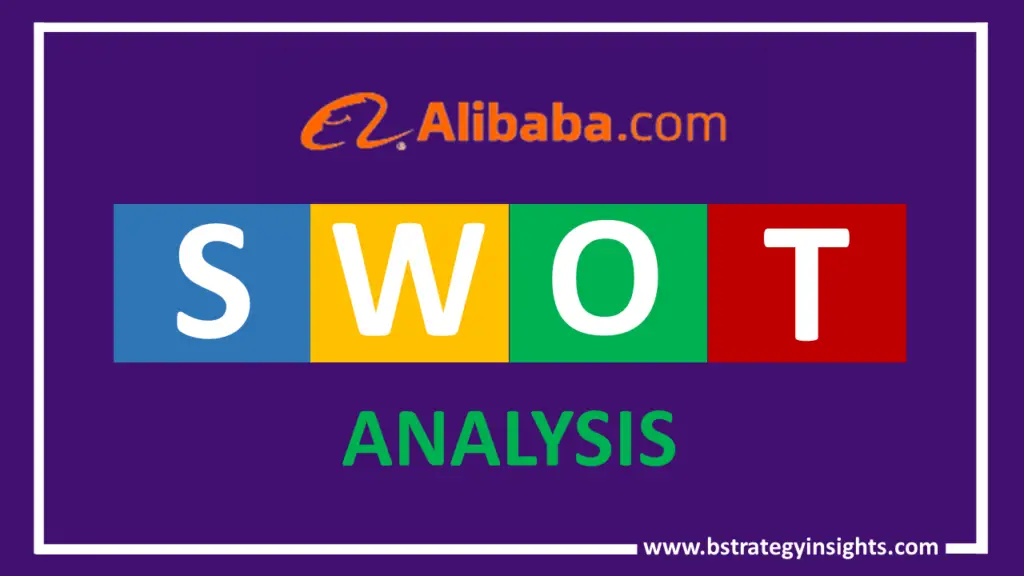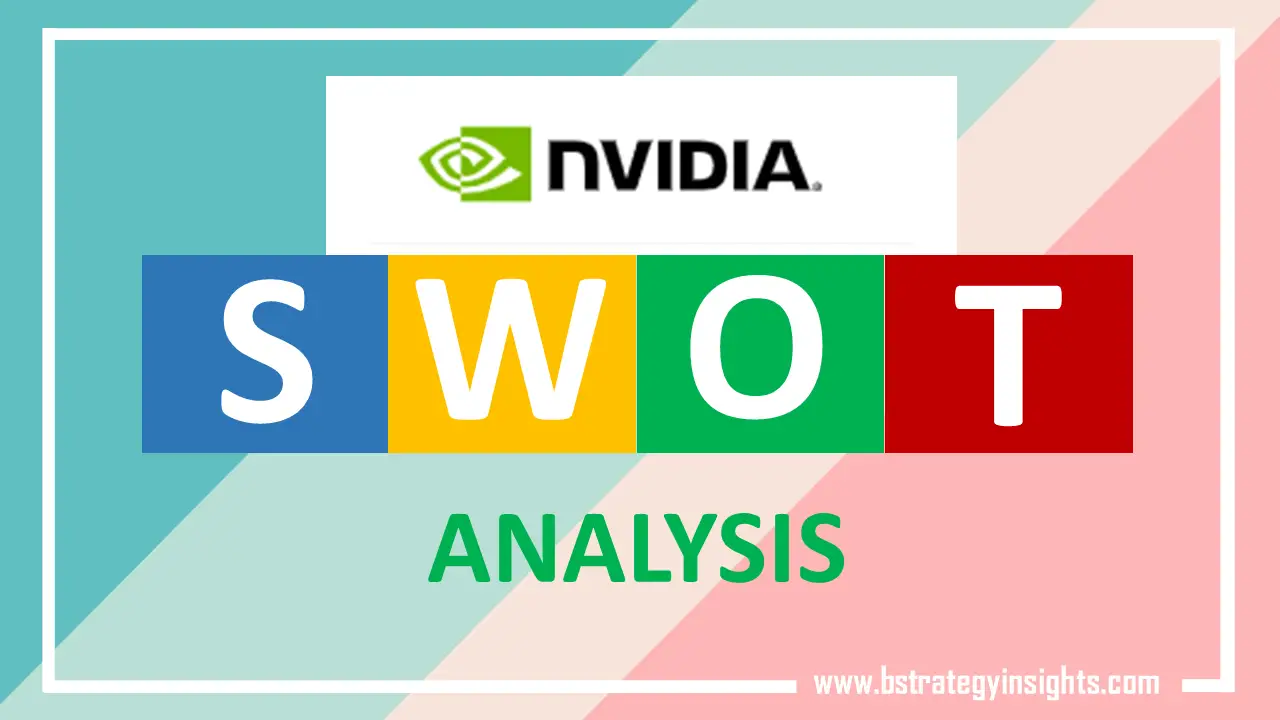
Nvidia is a multinational technology company that deals with designing graphics processing units (GPU) for the professional and gaming markets. For the mobile computing and automobile market, the company designs system-on-chip units. In addition, it manufactures parts and products that enhance computer graphics for gaming and other media by utilizing artificial intelligence.
Currently, Nvidia has its eyes on the high-level application of Artificial Intelligence in various fields, including health care, car technology, deep learning, and autonomous machines. And whereas this concept was initially designed by Toshiba and introduced into the market by Sony, by reference to PlayStation, Nvidia highly revolutionized the GPU Concept.
This article covers the SWOT analysis of Nvidia, including both internal and external strategic factors. The internal strategic factors include strengths and weaknesses, while the external factors include opportunities and threats. Before jumping into the detailed Nvidia’s SWOT analysis, let’s go through the basic highlight of the company.
Nvidia – At a Glance
| Name | Nvidia |
| Website | www.nvidia.com |
| Founders | Jensen Huang, Curtis Priem, Chris Malachowsky |
| Chief Executive Officer (C.E.O.) | Jensen Huang |
| Tagline | Work hard and go home |
| Headquarters | Santa Clara, Calif. |
| Type of Corporation | Public |
| Year Founded | April 5, 1993; 28 |
| Revenues (2025) | US$130.497 billion (For the period ending 26 January 2025) |
| Key Products/Services | Graphics processing units, Chipsets Drivers, Central processing units, Tablet computers, Data processing units, TV accessories, and Laptops, etc. |
| Key Competitors | Advanced Micro Devices, AVGO, TSM, and INTC, etc. |
A quick snapshot of the financial highlights of the company. Nnvidia’s revenue for the year ended 26th January 2025 was US$130,497 million; a significant increase from 2024, representing 114% growth (2024:US$60,922 million). The graph underneath shows Nvidia’s revenue worldwide from 2019 to 2025. As can be seen, Nvidia’s revenue had a big jump starting from 2024 and more than doubled in 2025. Its gross margin for 2025 is 75% compared to 73% in 2024. This represents a very healthy gross margin.
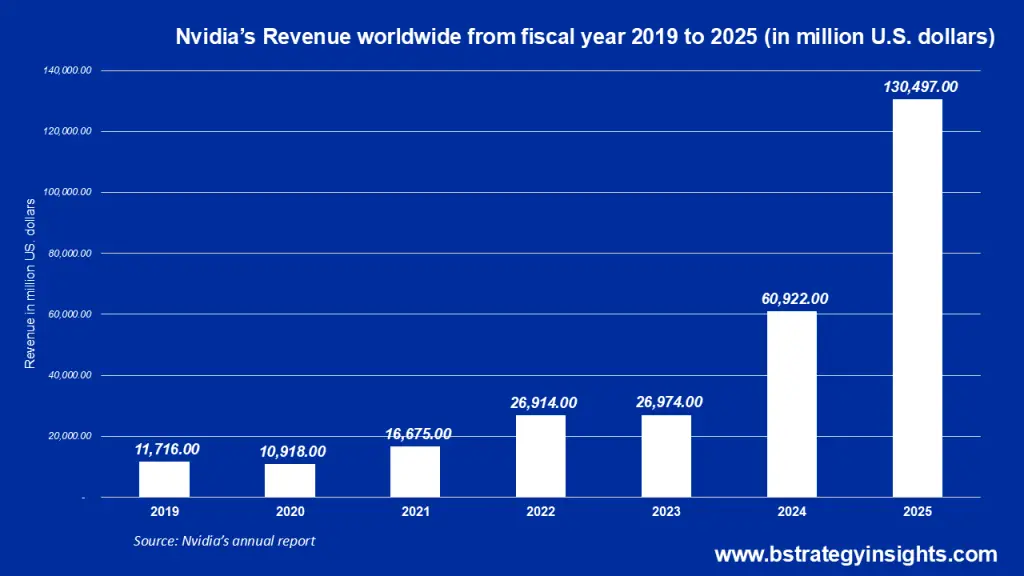
Nvidia’s Strengths
Innovation
Nvidia has transformed itself into a global leader in foundational technologies like artificial intelligence, Virtual reality, and advanced robotics, among others. Innovation has given the company a strong technological foundation. In 1995, Nvidia launched its first product, NV1. In 1999, it designed its GeForce 256 GPU and launched it in 2000, which was termed the world’s first GPU. In 2001, the company launched its first programmable GPU. With the nForce platform, the company was able to enter the integrated graphics market. It became the fastest semiconductor market to reach $1 billion marks in revenues and therefore joined S & P 500 companies.
In 2004, it launched SLI technology, which would sharply increase an individual PC’s graphics power. It released the CUDA architecture in 2006 and launched the Tegra Mobile processor in 2009. It launched Fermi Architecture in 2008, powered the fasted supercomputer in 2010, launched Kepler in 2012, launched Tegra X1 with deep learning. Launched Volta in 2017, and Turing in 2018, launched Nvidia Ampere GPU architecture in 2020. This is a strength because continuous innovation ensures shorter product lead times, boosts efficiency, ensures the sustainability of the company, and ensures great customer satisfaction for more profitability.
Strategic Partnerships and Acquisitions
Nvidia has had strategic acquisitions for its product expansion. This is one of the most important means of growth for a company. It improves synergies and has Nvidia build more on the strengths of the companies it acquires for the greater advantage of Nvidia and its product offering. The company’s first strategic partnership was launched with SGS-THOMPSON and TSMC. It then acquired Graphics pioneer 3DFX and Media Q, among others.
Strong Product Portfolio
Nvidia has a strong product portfolio that includes graphics, wireless communication, PC processors, and automotive hardware/software. This wide range of products gives Nvidia more leverage in defining and meeting particular customer needs and thereby improving its effectiveness in meeting customers’ wants and needs.
Nvidia’s CUDA ecosystem and a broad portfolio of GPUs create a sticky moat, enabling them to become an industry standard in AI research and production workloads. This led to a large developer community, extensive software libraries, and optimized performance across various workloads.
This demonstrates Nvidia’s great investments in research and development to ensure the company captures all the needs that are inherent in the market, so as to launch products that appeal to the company’s audience. The graph below shows the exponential growth in R&D from 2017 to 2025.
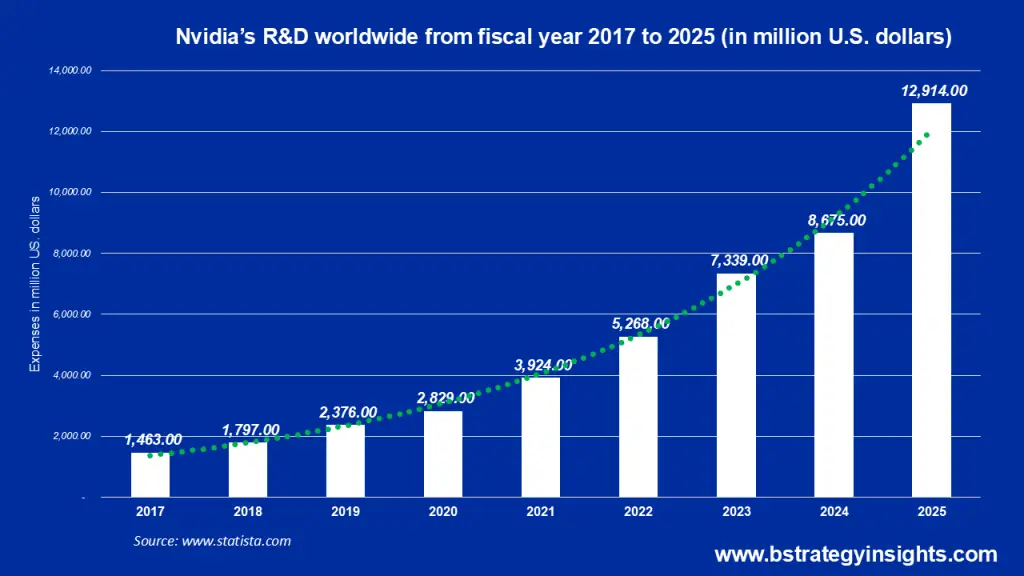
Strong Financial Performance with significant cash generation and balance sheet strength
Nvidia has recorded remarkable financial results in the recent past. The second quarter of 2026 (as of July 2025) recorded a 72.4% jump in revenues from the previous quarter; gaming and AI PC revenue rose by 14% (Q/Q) and up to 49% from a year ago (Y/Y), and data center revenues grew by 5% (Q/Q) from the previous quarter and up to 56% from a year ago (Y/Y).
Nvidia’s net income grew by 41% from the previous quarter and up to 59% from a year ago (Y/Y). This represents a strong net income growth year on year. In addition, Nvidia has a large asset base and a high return on expenditure.
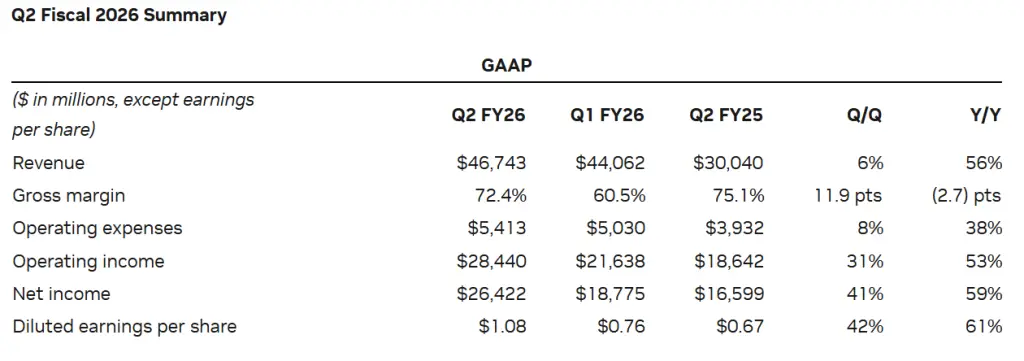
Sources: Nvidia’s Quarterly Result
The founder and CEO of Nvidia attributes this growth to strong demand for the company’s products. Additionally, the company found more opportunities for growth with the advent of COVID-19, which brought about a paradigm shift in how businesses operate, leading to a greater appreciation for Nvidia’s products and services.
In addition, Nvidia had substantial free cash flow (FCF), which enables the company to expand its research and development, as well as pursue a selective acquisition strategy.
Strong Brand, pricing power, and premium margin
Recognitions and high rankings by various industry players is a mark of confidence in Nvidia as a company and therefore go a long way to not only confirm the competitive strengths that the company has but also endorse the company to the global audience for the various efforts the company is making to deliver on its promise.
Nvidia is enviably a strong brand with impressive recognitions and commendations from the market. Therefore, the company has received numerous nominations and awards for its outstanding performances in various spheres of business operations.
In 2021 alone, the company had the following rankings and recognitions: it was second-best among America’s Most Responsible Companies by News, it was position 4 among Top 50 Large-Cap Value Creators, it was position 12 in both 100 Best Companies to Work For, and BrandZ Top 100 Most Valuable Global Brands, it was position 86 in Brand Finance US Top 100 and position 100 in Global 100 Most Sustainable Corporations.
In 2025, NVIDIA received multiple recognitions for its innovative technologies at COMPUTEX’s Best Choice Awards. This includes the NVIDIA GeForce RTX 5090 GPU, the NVIDIA Quantum-X Photonics InfiniBand switch system, NVIDIA DGX Spark, the NVIDIA GB200 NVL72 system, and the NVIDIA Cosmos world foundation model development platform.
The above awards and recognitions represent its continuing development and innovative technology, especially in the outstanding functionality, innovation, and market promise of technologies in each category.
Nvidia is recognised as a premium pricing for top-tier GPUs and accelerators in the industry. This recognition is because of its performance, leadership, and software advantages over its competitors. As a result, the company has high gross margins, which were supported by its product mix.
Strong Workforce
Nvidia has a highly skilled labor force that is diversified, with qualified and accredited professionals. The company is highly ranked in the industry for being the best place to work for.
Nvidia’s Weaknesses
Low Current Ratio
While the company has strong financial performance, the company’s financial ratios call for more effort to ensure safer margins. Nvidia has a low current ratio which may pose liquidity challenges in the event the company needs to meet its current financial obligations. The company’s rating is lower than the industry average. This could as well inch on the company’s cash flows.
Dependency on a Few Strong Products
While Nvidia has numerous products, not all of the products are performing strongly in the market. A few of the products have a high market share. This makes the company vulnerable to any threats that could threaten the few strong products. The company needs to increase its innovation to strengthen the rest of its products.
High Operational Costs
Some of the areas have caused an increase in operational costs, including rental expenses. A good number of the company’s premises are rented properties instead of purchased properties.
Additionally, with the advent of COVID, there were increased complexities in logistics and costs thereof. This increased the operational costs for most companies and thereby inched into the profits margin of the company. Therefore, Nvidia needs to focus on cost-cutting measures to increase its profit margins continuously.
Nvidia’s Opportunities
Internet and e-commerce
With the internet becoming increasingly ubiquitous, more and more customers and finding it easy to make their purchases online, thereby giving a boost to e-commerce. Nvidia needs, therefore, to sharpen its online sales strategy to make the most of this growth.
Technological Advances
Increased technological advances characterize this century. This includes the AI hardware demand, and hyperscale adoption continues to grow, as well as the increase in the need for automotive AI and autonomous systems, such as advanced driver-assistance systems (ADAS) and autonomous vehicle compute needs. These advances define innovation, sustainability, efficiency, and effectiveness, among others. While Nvidia has already invested heavily in technology, there are still more opportunities arising with every invention, and this calls for more alertness on the part of Nvidia to respond appropriately to technological changes in the market.
Diversification into new computing paradigms
Nvidia may further diversify into new compute paradigms such as quantum, interconnects, and DPUs. These further investments could future-proof its hardware stack. In addition, Nvidia could look into the differentiation of accelerators for networking, storage, and security, enabling an increase in its new revenue streams to the company.
Nvidia’s Threats
Increased Competition in the Market
Nvidia faces strong competition from both direct competitors, indirect competitors, and new entrants into the market. Increased competition pushes down prices to the advantage of customers but to the disadvantage of suppliers as it cuts down on profit margins.
In the event this becomes unsustainable, Nvidia would be facing the threat of incurring losses and eventually have a foreclosure.
Constant Changes in Technology
New technologies pose the threat of rendering a product redundant and eventually becoming obsolete. Therefore, Nvidia needs to innovate to evade any such eventuality continuously.
Cybersecurity and vulnerability exposure
Given that the computing platforms have grown, especially in terms of their importance, continued security vulnerabilities and supply chain tampering could potentially undermine the trust and adoption of their technologies.
Conclusion
Nvidia, by industry standards, is a leader. The company has invested so much in innovation and technology, and so far is reaping great rewards. However, the company needs to strengthen its products so that all of the company’s products perform strongly in the market, to increase revenues and liquidity for the company.


